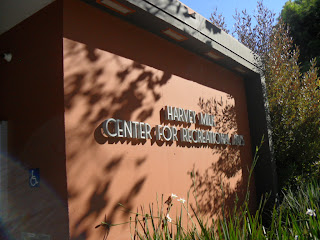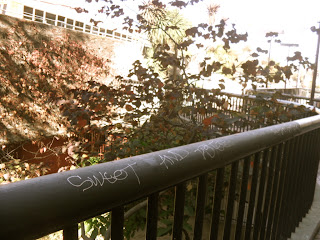I had never
been to North Beach before this experience with the class. I immediately knew I
would like it when I heard that the phrase “Little Italy” was associated with
it. I’m not sure exactly why, but I have always been drawn to the Italian
culture. It might have something to do with the fact that before nearly every
sporting event that I partook in growing up, we would have pasta and homemade
pizza for dinner.
I’m not sure if it’s just because I am a
big fan of Italian food or if the signage was particularly effective, but I
found myself drawn to many restaurants and cafes. Madeline and I were so eager
to experience some of the food and culture that we wound up visiting three
separate little eatery joints. The first one we popped into is famous for its
focaccia bread. It’s the only thing that they sell, but they sure do a good job
at it. I found it quite interesting though, based on the bakery’s appearance on
the inside and outside. From the outside, it didn’t really look like anything
special. In fact, if Stacy hadn’t recommended we go there, I doubt that
Madeline and would have been drawn to it solely by its outward looks. In a way,
it had a somewhat grungy feel to it. The inside was quite similar. It was very
empty looking, and there weren’t very many captivating visuals. However, the
focaccia spoke for itself, and I would certainly revisit for the beauty of the
bread.
After treating ourselves to the delightful
bread, we decided it would be worthwhile to trek up to Coit Tower. I certainly
did not regret this decision. Not only was the view breathtaking from up there,
but the murals and art work inside was definitely a sight to see as well. The
murals along the walls on the inside of the tower were part of a WPA project
like the murals inside of the Beach Chalet. Although they had a similar feel to
them, the murals inside of Coit Tower are much less well preserved than those
in the Beach Chalet. This could partly be because the Beach Chalet has turned
into a little museum and restaurant as well. Since more people visit and are
drawn to the Beach Chalet, people probably thought it more prominent to
preserve these murals. It was a little
saddening to see that nothing is being done to preserve the murals in Coit Tower
as they should be. Even with the weathering, they were still beautiful and
quite effective.
After making our down from the tower, we
decided it would only make sense to look around for gelato and a pastry or two.
After wandering up and down the streets a bit, we came across a very interesting
little business. We were drawn into it because of its uniqueness. It had signs
on the outside for cigarettes, ice cream, and sandwiches. It seemed like a
strange combination to us. Sure enough, upon entering we discovered that it was
indeed a smoke shop, deli, and gelato/ice cream shop all in one. Despite the
strange smells and vibes of the place, the gelato proved to be quite delicious
all the same. I tried the mango sorbet, and Madeline went for the raspberry
cheesecake. Both were recommendable choices.
As we were walking about with our gelato,
it seemed only right that we find a cute a little café to finish off our little
“tour of Italy.” We happened upon a very cute café that drew us in because of
the classy looks on the outside and inside. This is where it differed from the
previous two places we had visited. Rather than being slightly underwhelmed by
the atmosphere, we found it to be quite lovely and suave all at the same time.
Our taste buds were telling us to order something savory, so we went with the
ham quiche and a basil pesto tart. We walked back to Washington Square Park to
eat our little treats in the sun.
North Beach is well known for its red light
district and lively nightlife scene. Although it is surely more prominent
during the nighttime, the signage was still visible during the day. Since North
Beach use to be home to the infamous Barbary Coast due to the close proximity
of the docks, it makes sense that this is now the red light district. When you
get a chance to get a good look at the signage, the history and relevance of
everything in the North Beach area becomes clear. Although much has changed
over the years, the basic culture and purpose has remained the same.



















